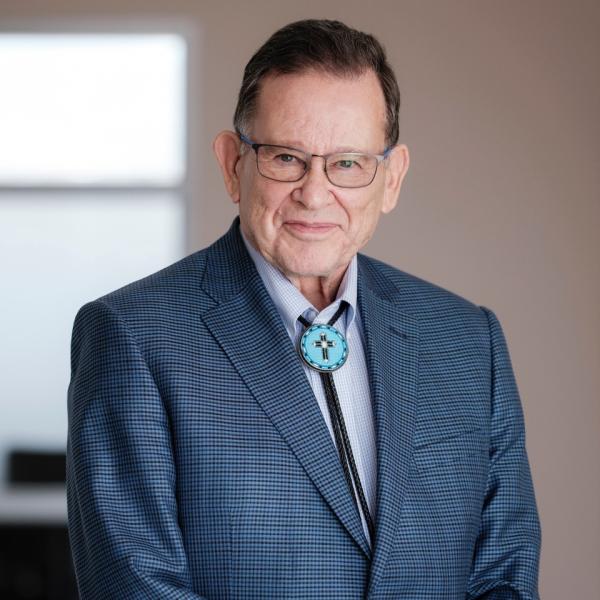Robert Martin
National Humanities Medal
2022

—Photograph by Jason S. Ordaz, Institute of American Indian Arts (IAIA), 2024

—Photograph by Jason S. Ordaz, Institute of American Indian Arts (IAIA), 2024
Robert Martin, an enrolled member of the Cherokee Nation, was born in Pryor, Oklahoma, in 1946. Most of his relatives lived in Cherokee country around Tahlequah and Jay, Oklahoma. In elementary school, his family relocated from Oklahoma to North Carolina; his father worked in construction. In high school, Martin remembers voicing an interest in working with Indigenous communities on a reservation or other Native community. In response, he says that “a lot of people looked at me a little weird, maybe [thinking] that wasn’t ever going to happen,” but his “vision/dream” as he calls it, came true. He has spent a lifetime working in Indian education, a career that has centered him within numerous Indigenous communities.
While in North Carolina, he earned his bachelor’s and master’s degrees from Appalachian State University. After having taught in West Virginia and North Carolina, at two historically Black institutions, he moved back to the Plains when a position opened up mid-semester at what was then known as the Haskell Indian Junior College. He drove to Lawrence, Kansas, arriving on a Sunday, having to teach that Monday. At Haskell, he learned a lot about his Cherokee people and the many tribes whose members made up the diverse student body. Although he eventually left the teaching job at Haskell, he returned years later as its president.
Martin’s first presidential position was at Southwestern Indian Polytechnic Institute in Albuquerque, New Mexico, from 1981 to 1989. The college was on the brink of closure when he arrived, but through grassroots organizing and the support of students, local tribal leadership, and other advocates, the school remained open. He then served as president of Haskell Indian Nations University from 1989 to 1999. Under his direction, the school transitioned from a junior college to a university offering baccalaureate programs. While president at Haskell, he pursued a doctorate in educational leadership at the University of Kansas. When he was president of Tohono O’odham Community College in Sells, Arizona, from 2001 to 2005, the school acquired its accreditation. He also worked at the University of Arizona in Tucson as professor and associate head of the American Indian Studies program.
“To Lead Is to Serve,” is not only the title of an article written by Martin for the Tribal College Journal of American Indian Higher Education but the foundation of his approach to leadership. In that article, he states, “Indigenous leadership stems from knowledge that is focused on empowering the entire community. Indigenous warriors are cultural and spiritual leaders who are responsible for protecting the land, health, and welfare of each community member.” He draws inspiration from traditional leaders such as Black Elk (Oglala Lakota), who articulated the concept that all living things are connected and interdependent. Martin elaborates, “If you look at traditional Indigenous leadership, I think that no matter what tribe you’re talking about, it’s so important for the leadership to listen to the people and to be of service to the people.” He credits his many mentors for showing him what leadership looks like and for instilling in him the value of hard work and the importance of surrounding oneself with positive role models.
In his current role as the president of the Institute of American Indian Arts (IAIA) in Santa Fe, New Mexico (a position which he has held since 2007), Martin continues to strengthen the school’s mission of promoting creativity and leadership through Indigenous arts and cultures, encouraging lifelong learning, and cultivating community engagement. IAIA was established in 1962 as a high school for the arts. Like other tribal colleges, IAIA has existed in contrast to federal boarding schools established in the late nineteenth century, which attempted to assimilate Native American children into mainstream culture by removing them from their tribal communities. Martin points out that that’s where tribal colleges have been different. Rather than Native culture being discouraged, students at IAIA were encouraged to practice their culture, traditions, and history. That was, in fact, the anchor of IAIA’s mission. From that point, the students were encouraged to be innovative and creative.
Nearly 40 tribal colleges are now located throughout the United States on or near reservation lands, serving predominantly Native American populations. They provide opportunities for students to pursue advanced degrees in liberal arts, sciences, and workforce development, guided by culturally relevant curriculums and missions grounded in self-determination, tribal sovereignty, and community.
Martin acknowledges the unwavering support of his wife of 37 years, “I couldn’t do my work without her.” He is married to Luci Tapahonso (Navajo), professor emerita of English literature at the University of New Mexico and inaugural Poet Laureate of the Navajo Nation. Together, they have a blended family with five children and many grandchildren.
—Kimberly Suina Melwani